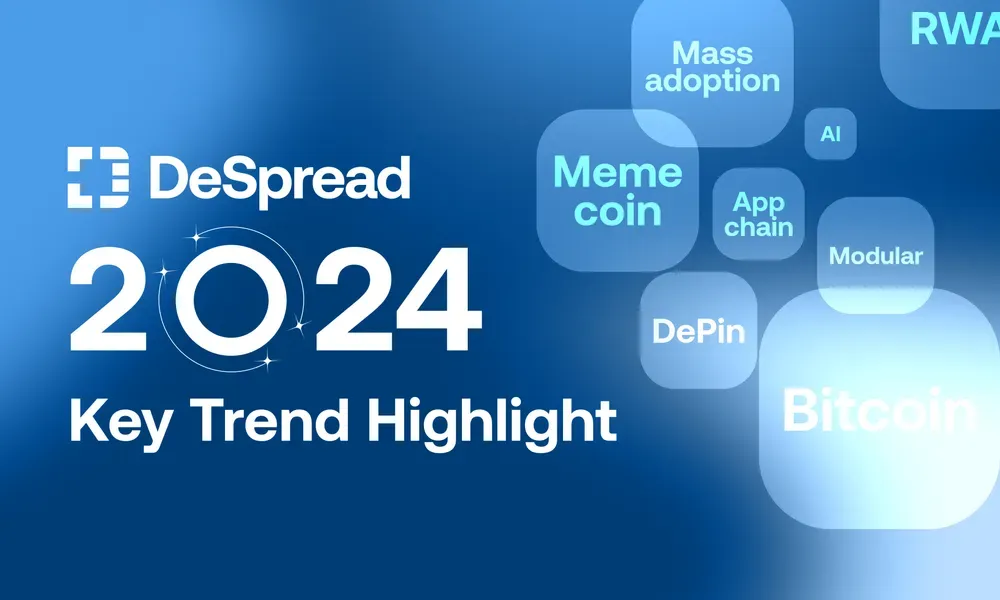
2024 Key Trends Highlighted by DeSpread
Let's explore the key trends for 2024 that industry leaders are focusing on | Edited by Eunji Cho
Disclaimer: The opinions expressed in this article are those of the interviewer and do not represent the official statement of DeSpread. Nothing contained in this article is investment advice and should not be construed as such.
DeSpread, A Web3 Market Strategy Consulting Firm: Unearthing Projects with Deep Market Potential Since 2019
Since 2019, DeSpread has specialized in identifying projects with substantial market potential and has adeptly facilitated their market entry. The individual skills of DeSpread team members, sharpened through extensive practical experience, are regarded as unparalleled in the industry. Their expertise lies in quickly discerning and adeptly navigating the dynamic shifts in market trends.
This article highlights the key trends for 2024, closely monitored by every member of the DeSpread team. We will delve into the ten most frequently mentioned trends in the following sections.
Jason Ye | Co-CEO

This year’s key trends are modular, DePIN, and RWA.
I foresee a year where the potential of various modular blockchains will be experimented with, and dApps will begin using modular chains suited to their environments. Modularization across multiple layers, such as Arbitrum, Optimism, and zkSync in the computation layer, and Celestia and EigenDA in the data availability layer, will bring cost reduction, efficiency, and flexibility to blockchain developers.
Additionally, the advancement of AI technology has increased the need for storage, GPUs, and other resources. To address this, services combining blockchain with token incentive models are expected to emerge. Token incentives will attract more users and expand shared infrastructure, leading to economies of scale and reduced costs.
Lastly, the launch of Bitcoin spot ETFs will spark more institutional interest in decentralized assets. I anticipate an increase in efforts to move real-world assets like stocks, bonds, and real estate onto the blockchain. Furthermore, brokerages are expected to launch their own Security Token (ST) platforms, preparing for fractional investment and various tokenized security products.
GM Chung | Co-CEO

I believe 2024 will be a year when new use cases based on Bitcoin flourish.
2023 showed new possibilities for Bitcoin-based development with basic use cases like inscriptions utilizing the Ordinals protocol and BRC-20. This year, we expect to see higher-order on-chain use cases, previously seen in smart contract platforms like Ethereum, emerge on Bitcoin. Bitcoin Layer 2 solutions, especially Stacks, will play a significant role in expanding the scope of application implementation.
Bitcoin, recognized as the world’s most accessible and liquid asset, gains further significance when integrated onto the blockchain, beyond mere centralized exchange trading. This integration allows universal utilization of an asset valued at 850 billion dollars. Developments such as the approval of Bitcoin spot ETFs are drawing increased attention to the Bitcoin ecosystem. The current year is seen as the prime time for these advancements.
Mark Shim | Co-founder

The launch of the Bitcoin spot ETF marks the beginning of a direct market participation by ‘institutions,’ a topic that has been a buzzword in the blockchain market for years. Therefore, I predict a comprehensive overhaul in the blockchain industry, both in terms of personnel and structure, this year.
New players entering the market could quickly overshadow existing ones. Hence, maintaining a high level of competitiveness is essential to stay at the forefront of this market.
Most of the new market participants are coming from traditional financial markets and the tech industry. These newcomers and crypto-natives must swiftly and flexibly bridge the industry differences. Ultimately, the players who overcome this will emerge as winners in this cycle.
*Crytpo-native: Individuals who have shown an early interest in virtual assets and blockchain markets.
Kevin Hwang | Director

I anticipate the emergence of new models that will sustain the on-chain activities of Web3 newcomers.
Last year saw an increase in new on-chain users due to developments like soulbound tokens and airdrops from major Layer 2 projects. This led to various on-chain ecosystems, but they were short-lived. New users only followed new on-chain trends, and the increasing user count was merely a bubble. Therefore, this year I believe business models that can maintain new users’ on-chain activities will lead the trend.
A promising area in this regard is ‘Intellectual Property (IP).’ In the Web2 market, there has been an increase in demand for video platforms like Netflix and YouTube, and the importance of content created by creators has grown. Similarly, in the Web3 industry, I hope to see the release of products with strong IPs in games or other categories that can retain new users beyond short-term engagement.
Jun Park | Senior Consultant

This year calls for a new approach to mass adoption.
Over the past few years, the blockchain industry has continually and rapidly grown, experiencing various projects and trends. From the popularization of Bitcoin to new ventures in Decentralized Finance (DeFi) and Non-Fungible Tokens (NFTs), numerous issues have constantly arisen. Recently, there has been discussion on various projects that could lead the trend, including AI and Parallel Chains.
However, as much as the market has grown, this year necessitates a serious consideration of rigorous evaluation and the real potential for commercialization. This is especially important in light of the expected new capital inflows following the approval of the Bitcoin spot ETF. Projects that fail to be practically utilized or achieve their objectives are unlikely to maintain their current market capitalization.
In summary, while the industry continues to grow steadily, there is a need to focus on mass adoption to move blockchain technology into a phase of genuine innovation and adoption, ensuring it has a substantive impact in the real world.
Jeff Kim | Director

I expect the DePIN narrative to continue receiving attention, following its trend in 2023.
DePIN is a technology that uses the crypto-economy model to build and deploy physical infrastructure and hardware networks. I believe DePIN will become an example of applying basic infrastructure of the real society to the blockchain in the future.
Until now, the management of physical infrastructure has been monopolized by large corporations. However, I foresee the possibility of cost reduction, ownership for network contributors, healthy competition, and the influx of new users to utilize such infrastructure through DePIN’s decentralized infrastructure.
Earl Cho | Senior Consultant

The blockchain market in 2017 focused on the utility aspect. Then, in 2020, on-chain utility emerged through DeFi and NFTs, leading to increased network usage and on-chain liquidity. However, concerns about the limits of growth due to difficulties in actual commercialization were raised.
This year, I foresee a transition to the next stage, where on-chain and the real world will become interconnected. As a precedent, we can look at various cases emerging from RWA and DePIN-related businesses that have been attempted since 2022.
Therefore, I plan to closely observe which public chain ecosystem will achieve the most integration with the real world. Candidates include Bitcoin, Ethereum, and Ethereum Layer 2.
Particularly in Bitcoin Layer 2, Stacks is expected to continue Bitcoin’s advantages while complementing usability aspects. In Ethereum Layer 2, Arbitrum is predicted to act as the scaling solution with the most on-chain activity and liquidity, while Astar Network is forecasted to become an ecosystem that explores blockchain utilization and mass adoption led by national entities.
Teyun Kwak | Senior Researcher

I predict an expansion of the narrative around decentralized resource sharing for AI.
The scarcity and rising costs of GPUs (Graphics Processing Units), essential for AI computation, are gaining attention. This is due to GPUs being crucial for AI operations and deep learning tasks. The importance of GPUs will significantly impact not only the advancement of the AI sector but also the growth of the supporting decentralized resource sharing systems.
Projects in this area that I’m focusing on are Render and Filecoin. Render provides a GPU-based distributed computing network, enabling AI researchers and developers to access the computing resources they need. Filecoin enhances the secure storage and accessibility of AI data by providing distributed storage space.
Given AI’s potential to drive technological advancement and innovation, securing GPUs for AI and supporting blockchain-based projects will become an important narrative.
Leo Yu | Senior Developer

I anticipate significant changes in the blockchain ecosystem centered around ‘AI integration’ and ‘enhanced infrastructure’.
The role of AI, integrated with blockchain technology, will extend to data analysis and providing intelligent, customized services. For example, it will contribute to maximizing blockchain efficiency through the automation and optimization of smart contracts, enhanced security through transaction pattern analysis, etc.
The enhancement of blockchain infrastructure is expected to improve network speed and stability. Users will experience faster transaction processing speeds and lower transaction costs, which will be a crucial step for mass adoption. Additionally, improvements in scalability and interoperability will facilitate smoother interactions among various blockchain networks.
In conclusion, AI and enhanced infrastructure will bring blockchain technology closer to everyday life. The advancement of these technologies will lead the blockchain ecosystem in an innovative direction and open doors to new possibilities.
Jonathan Oh | Senior Consultant

For the industry to flourish, a strong emphasis must be placed on security and trust.
The Web3 market has rapidly evolved with many challenges and their respective solutions. Numerous projects have emerged to overcome Ethereum’s limitations, and recently, the Data Availability (DA) layer aiming to achieve Ethereum’s scalability has gained attention.
As such, this market is technically advancing day by day. However, many unfortunate incidents have occurred, making it difficult for new users to enter this industry. Events like the ‘Luna crash,’ ‘FTX bankruptcy,’ and ‘major hacking incidents’ have caused many people to lose money, creating a perception of a risky market for newcomers.
Therefore, I believe ‘security’ and ‘trust’ are the keywords for 2024. It’s a time to focus on what measures protocols are taking to ensure higher security over new and innovative technologies, and how they are preparing for emergencies with solutions like insurance reserves. Building trust and communicating with the community will become increasingly important.
Do Dive | Senior Researcher

With the approval of the Bitcoin spot ETF, I believe it’s crucial to pay attention to Bitcoin Layer 2, modular projects, and the Solana ecosystem.
The approval of the Bitcoin spot ETF has significantly expanded Bitcoin’s stage. Not only that, but the emergence of Ordinals, BRC-20, and the upcoming Nakamoto release are raising expectations for the expansion of Bitcoin’s utility, especially through Bitcoin Layer 2 projects like Stacks. We should closely watch how the Bitcoin ecosystem, now with richer capital and more diverse potential uses, progresses this year.
Next, the launch of Celestia and the Dencun update have increased interest in DA layers and modular projects. Modular approaches, representing a kind of division of labor in chain building, are bringing fresh projects to the crypto community that we haven’t seen before. Hence, it’s worth paying attention to the transformative wind that modular projects will bring.
Solana has established itself as a strong community among Non-EVM projects. Despite suffering greatly from events like the FTX bankruptcy, it is signaling a resurgence with projects like Jupiter, Jito, and Tensor quickly taking their place in the ecosystem. I look forward to seeing what steps the Solana ecosystem, which has already made significant headlines, will take next.
Logan Lee, a.k.a. Moneystack | Consultant & Content Producer

I predict this will be the inaugural year for unique and practical dApps.
Following the approval of the Bitcoin spot ETF, the blockchain industry is expected to explore a variety of cases once again. Over time, many failures have accumulated in this industry, serving as lessons for builders to develop dApps more quickly and with fewer mistakes.
Existing concepts like PerpDEX (Perpetual Futures Exchanges), casinos, and P2E will further refine their dApps. At the same time, new concepts in DeFi using RWA, and innovative experiences like Friend.tech will emerge, heralding another golden era of dApps.
The most anticipated sector is the full activation of Bitcoin DeFi. I believe the next step after the Bitcoin spot ETF is to explore ways to achieve capital gains based on Bitcoin. I expect a strong performance from projects leveraging Bitcoin Layer 2 for issuing collateral stablecoins and loans, as well as projects like Babylon Chain that utilize Bitcoin’s capital strength.
Declan Kim | Researcher

I believe this year will see an expansion of crypto’s influence to even those unfamiliar with the industry, through the fusion of traditional assets with stablecoins, token securities, and ETFs. Central to this are government, financial institutions, and global asset management companies entering the market.
In Korea, with the Financial Services Commission and securities firms at the forefront, the launch of the token securities market is gaining momentum. The Bank of Korea plans to start public participation tests for a CBDC that can be used just like cash in the fourth quarter of next year.
In Japan, the revised stablecoin bill has been officially implemented, establishing regulations. Financial institutions including Mitsubishi UFJ Financial Group have signed agreements to issue stablecoins with Binance Japan, and Ginco, an institutional Web3 wallet provider, announced plans to issue XJPY (Yen stablecoin) and XUSD (Dollar stablecoin) within this year.
Lastly, the approval of the Bitcoin spot ETF is a significant event this year, promising not only substantial capital inflows from global asset management companies but also opening the door for ordinary investors.
Gome Lee | Senior Consultant

Despite many developments in the Web3 industry, there still lacks elements attractive enough for new users to enter Web3. Therefore, I believe the Web3 industry should focus on mass adoption this year.
It’s been about 5 years since the inception of smart contracts and the start of on-chain activities. During this time, Layer 1 and 2 projects have offered lower transaction fees and faster speeds compared to the past, and existing DeFi and gaming projects have launched new items, learning from past failures. However, the influx of new users is still challenging compared to these efforts.
I think this is due to the lack of effort in onboarding Web2 users to Web3. Although it’s been about 5 years since smart contracts started and on-chain activities began, there is a shortfall in the aspect of Web3 onboarding. Therefore, instead of looking for elements that will bring new users into Web3, it’s crucial to uncover attractive elements that will make Web2 users want to use Web3.
Juhyuk Bak, a.k.a. MORBID-19 | Content Producer

Recently, there has been significant anticipation around the Bitcoin spot ETF, and the Bitcoin halving event is following suit. The issue of the security budget tied to the ‘halving’ phenomenon is leading to debates related to Bitcoin’s use cases.
The reason Bitcoin purists are currently upset on X (formerly Twitter) is that there is no single right way to use Bitcoin. At the center of this is Ordinals. I have bet that Bitcoin’s meta-protocols, led by Ordinals, cannot be stopped. I am focusing on what could enhance the capital efficiency of assets created through these meta-protocols, especially BRC-20.
In summary, I am paying attention to the infrastructure and dApps that can effectively utilize the liquidity of the Bitcoin ecosystem, including Layer 2 and bridges that transfer assets to other chains.
Andy Park | Senior Consultant

I think this will be an important year for the Bitcoin ecosystem.
With the Bitcoin spot ETF and halving scheduled for early this year, not only Bitcoin itself but also the Bitcoin ecosystem is receiving a lot of attention from the market. While last year Ordinals and BRC-20 created a buzz in the crypto community, this year the future direction of the Bitcoin ecosystem will be determined based on the infrastructure development.
Keonwoo Lim, a.k.a. Bulmat | Researcher, Data Analytics

I anticipate increased attention towards AI (Artificial Intelligence) technology. While AI technologies like AlphaGo and facial recognition have been novel and intriguing experiences for the public, their application in daily life has not been straightforward for the average person.
Last year witnessed the widespread adoption of ChatGPT, signaling a swift integration of AI technology into various everyday domains. Remarkably, ChatGPT exceeded 100 million monthly users within just two months of its launch, outpacing the growth of platforms like Instagram. This surge has heightened expectations for the developmental potential and impact of AI.
This year, I anticipate the emergence of a robust AI narrative within the crypto market, with related sectors gaining traction. Concurrently, the convergence of crypto and AI could give rise to the concept of uncensorable AI, a development that might provoke controversy due to its nature of being beyond centralized control.
Additionally, I believe the Meme Coin market will continue to receive attention and not fade away. This is because the speculative demand triggered by the GameStop incident, referred to as a meme stock, signaled the start of a significant trend.
Henry Kim, a.k.a. Gaeko | Consultant

I foresee a significant expansion of the Arbitrum ecosystem.
The Ethereum ‘Cancun-Denver upgrade,’ which includes the EIP-4844 update, is expected to improve the scalability and gas fee issues of the EVM ecosystem. This expectation has started attracting attention to the EVM-based Layer 2 ecosystem.
Especially notable is the vitality of the Arbitrum ecosystem. Recently, the number of active protocols on Arbitrum has surpassed 500, more than double that of its major competitor, Optimism. This difference seems to stem from the divergent initial market entry strategies of the two projects. While Arbitrum supports the growth of many ecosystem protocols in a short period, Optimism focuses on supporting a few protocols that contribute to the ecosystem in the long term.
Thus, Arbitrum represents an ideal space for new projects to unfold fresh ideas. Additionally, there are movements to lead the narrative, such as introducing Orbit-based Layer 3 like Xai (Orbit).
I expect keywords such as Arbitrum Orbit, custom gas tokens, and $ARB staking will make Arbitrum stand out more, especially after the EIP-4844 update in 2024.
Eunji Cho | Consultant, Media Communication

I predict an increase in Web3 dApps that mimic Web2 apps or decentralized versions of Web2 apps.
Last year, the advent of OpenAI’s ChatGPT led to a gradual increase in AI chatbot-based dApps in the Web3 industry. Before this, the data ownership of app users was a hot topic, leading to the emergence of decentralized social platforms like the Lens Protocol and the BASE chain-based social networking service, Friend.tech. Friend.tech is an app where you can trade tokens representing people, allowing communication with the tokenized individual, similar to the domestic idol communication app, Bubble.
Ultimately, to transition to Web3, we need to break down the barriers between Web2 and Web3. To achieve this, an environment that makes it easier for users currently on Web2 to enter Web3 is expected to be developed.
Livet Kwack | Developer

Significant events like the Bitcoin spot ETF approval and the upcoming halving are scheduled in the Bitcoin ecosystem.
Contrary to many experts’ opinions about the initial virtual asset market, the successful approval of the Bitcoin spot ETF can be seen as a positive trend. It serves as a good means of instilling trust in liquid assets that were previously confined to the traditional spot market.
Along with this favorable wind, the Bitcoin ecosystem has started to buzz with life. Activities previously possible only with Ethereum’s smart contracts are now happening. This signifies new use case possibilities for Bitcoin and will serve as a solid foundation for the industry’s development.
Jaewon Choi, a.k.a. Coblin | Consultant

With the launch of Celestia, I expect interoperability technologies that bridge app chains to gain attention in the blockchain market.
Until now, dApp projects have built expertise based on general-purpose Layer 1 blockchains. I believe these dApp projects will easily build modular blockchains based on various blockchain toolkits available in the market and data availability solutions provided by Celestia.
This will enable smart contract-based dApps to overcome the unreasonable structure of having to pay excessive costs to the blockchain for infrastructure use. For instance, it could offer opportunities to build sustainable tokenomics, such as extending token utility limited to governance into user network fees.
Through this, anyone can conveniently contribute to the blockchain and receive corresponding rewards, creating an environment conducive to participation.

“Providing a Refined Perspective for Web3 Pioneers”